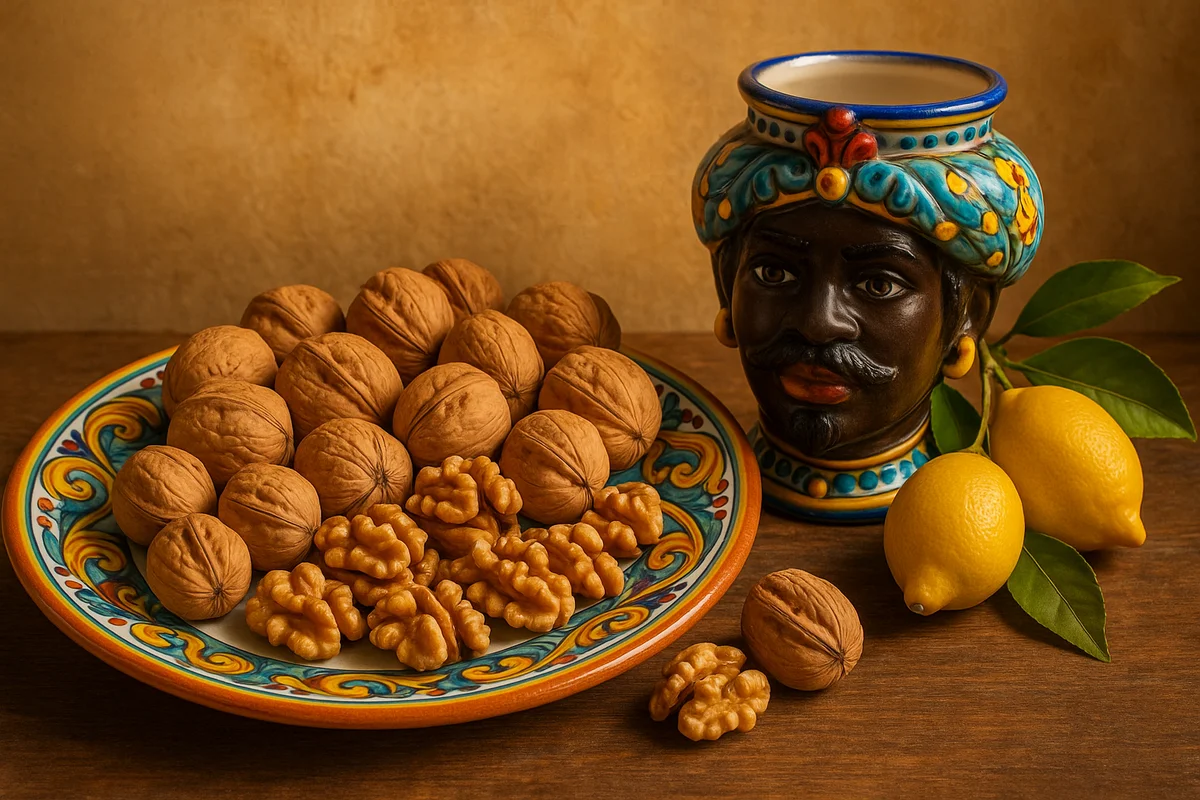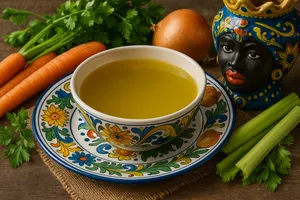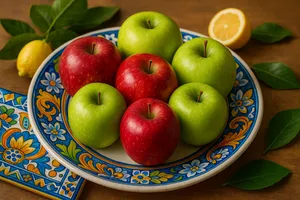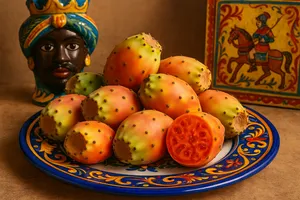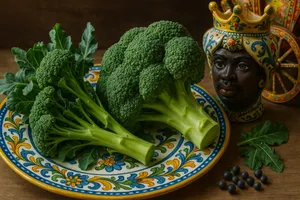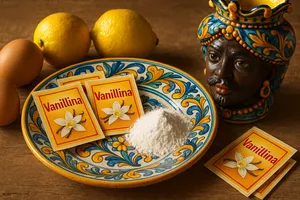Overview
Walnuts, known in Sicilian as “nuci”, are the fruit of the walnut tree (Juglans regia), a majestic species originating in Central Asia and cultivated for millennia throughout the Mediterranean. These oily seeds, enclosed in a hard, ridged wooden shell, are prized for their rich, gently bitter flavour, crisp texture and excellent nutritional qualities. Among the oldest foods consumed by humankind, walnuts have long held an important place in Sicilian cuisine and culture.
In Sicily, walnut trees thrive in hilly and mountainous areas, where the cooler climate favours production. Every farmhouse and mountain hamlet traditionally had century-old walnut trees offering deep summer shade and precious autumn fruit. Fresh walnuts, harvested in September and October, were eaten at once or dried for winter storage. They feature in many traditional pastries: Christmas sweets, biscuits, nougat, almond pastries enriched with walnuts, as well as the classic pasta with walnuts. Beyond culinary use, the walnut tree was valued for its fine wood and dense shade, though feared for its allelopathic effect, which suppresses the growth of nearby plants. Today, Sicilian walnuts remain a key ingredient in the island’s cooking, symbolising autumn and festive traditions.
Characteristics
Walnuts are enclosed in a hard, ridged wooden shell, rounded or oval in shape and light brown in colour. The shell consists of two halves that open to reveal the kernel-the edible part-divided into four lobes separated by thin wooden membranes.
The kernel has its characteristic lobed form, beige or light brown colour, and a wrinkled, convoluted surface. It is covered by a thin brown skin with a faint astringency. The texture is crisp when fresh, becoming softer if stored for long periods or if the walnut is old.
The flavour is rich, slightly sweet with a distinctive bitterness, oily and intense. The aroma is that of fresh nuts, with a faintly herbal note in newly harvested walnuts. Fresh walnuts have a more delicate flavour and softer texture than dried ones.
High-quality walnuts feel heavy for their size (if they feel too light they may be empty or dried out), and the kernels should be intact, evenly light in colour, free from dark spots or rancid odour.
Varieties
Several walnut varieties exist, differing in size, shape, shell thickness, flavour and yield.
Sorrento walnuts
A renowned Campanian variety, large, thin-shelled and with generous kernels. Their flavour is delicate and they are considered among the finest Italian walnuts. Not native to Sicily, but cultivated in some areas.
California walnuts
Imported from the United States, these walnuts are large, uniform, with pale, smooth shells and a delicate flavour. They are the most common supermarket variety, available year-round. Their quality is good, though many prefer Italian varieties for their more distinctive taste.
Local Sicilian walnuts
Traditional varieties cultivated in Sicily, often uncatalogued but passed down over generations. They vary in size, have a more intense, characteristic flavour and sometimes a harder shell. They are valued by connoisseurs for their authenticity.
Grenoble walnuts (France)
A high-quality French PDO variety with thin shells and pale, sweet kernels. Appreciated internationally.
Cultivation in Sicily
In Sicily, walnut trees grow in hilly and mountainous areas, preferring altitudes of 400–900 metres, cooler climates with temperature variation, and deep, fertile, well-drained soils. Major areas include the Nebrodi, Madonie, Iblei Mountains and the inland Palermo region.
The walnut is a majestic tree, reaching 20–25 metres with a broad, dense canopy providing deep shade. It grows slowly but can live for centuries. Flowering occurs in spring (April–May), with both male (yellow catkins) and female (small green) flowers on the same tree.
The fruit ripens in autumn (September–October). Initially green and enclosed in a fleshy hull, it darkens and splits as it matures, releasing the wooden-shelled walnut. Traditionally, harvest involved beating the branches with long poles to make the nuts fall, then collecting them from the ground. Today mechanical shakers are used in intensive orchards.
After harvest, the nuts are removed from their hulls (“smallatura”), washed and dried in the sun or in drying rooms. Drying reduces kernel moisture, allowing months of storage.
Fresh vs dried walnuts
Fresh walnuts: Newly harvested, with hull still green or recently removed. They have pale kernels, a softer, more humid texture, delicate, slightly milky flavour, and a skin that peels easily. They must be consumed within weeks as they spoil quickly. In Sicily, fresh walnuts are eagerly awaited each autumn and considered a seasonal delicacy.
Dried walnuts: Those dried after harvest and suitable for long storage. They have darker kernels, crisp texture, more intense flavour and a more adherent, astringent skin. These are the walnuts available year-round.
Culinary use in Sicilian cooking
Walnuts have countless uses in Sicilian cuisine.
Pasta with walnuts
A traditional preparation in which chopped walnuts are combined with garlic, oil, Parmesan and toasted breadcrumbs to create a rich, creamy sauce for pasta. It is an autumn dish, hearty and flavourful.
Christmas sweets
Walnuts play a starring role in Sicilian Christmas pastries: buccellati (filled with dried figs, almonds and walnuts), nucatoli (filled with walnuts, honey and spices), mustazzoli (spiced biscuits with walnuts) and walnut nougat.
Biscuits
Many Sicilian biscuits contain chopped walnuts: walnut biscuits, almond pastries enriched with walnuts, and rustic dipping biscuits.
Salads
Chopped walnuts enhance mixed salads, adding crunch and flavour. They pair well with bitter greens (radicchio, escarole), cheeses (gorgonzola, goat’s cheese) and fruits (pears, apples, grapes).
Walnut pesto
Similar to Genoese pesto, prepared with walnuts, garlic, oil, Parmesan and ricotta or mascarpone. Creamy and rich, ideal for pasta, gnocchi or crostini.
Meat sauces
Chopped walnuts enrich sauces for roast or boiled meats. A traditional Sicilian sauce combines walnuts, garlic, parsley, soaked breadcrumbs and vinegar for an intense dressing.
Fillings
Walnuts are used in fillings for vegetables (courgettes, aubergines, peppers), ravioli and agnolotti, adding depth and character.
Preserves and jams
A particular preparation involves green walnuts preserved in spiced sugar syrup. Labour-intensive but unique in flavour.
Walnut liqueur
Nocino is a liqueur made by macerating green walnuts (traditionally picked on the night of Saint John) in alcohol with sugar and spices. It is dark, aromatic and bitter, and is a traditional digestif.
Preparation
To use walnuts, the shell must first be opened. A nutcracker (lever or screw type) is used, or traditionally the shell could be cracked between two flat stones. Once opened, remove the kernel carefully and check for shell fragments.
The kernel’s thin brown skin has a light astringency. For certain preparations it is removed by blanching the walnuts for 2–3 minutes, draining and rubbing them to peel the skin. Peeled kernels are paler and milder in flavour.
Walnuts can be chopped with a knife (for coarse pieces), in a food processor (for medium or fine texture), or in a coffee grinder (to make walnut meal). They release oil when processed, so avoid over-grinding to prevent them becoming pasty.
Toasting walnuts-an essential step for enhancing flavour-can be done on a baking tray at 150–180°C for 8–10 minutes, stirring halfway, or in a pan over medium heat for 5–8 minutes, stirring constantly. They should turn lightly golden and fragrant, not burnt.
Storage
Walnuts in the shell keep in a cool, dry, dark place in jute sacks or ventilated containers for 6–12 months. The shell protects them from oxidation and rancidity.
Shelled walnuts keep in airtight containers in the refrigerator for 2–3 months, or in the freezer for 6–12 months. They must be protected from air, as their high content of unsaturated fats makes them prone to rancidity.
Chopped walnuts keep for shorter periods (1–2 months in the refrigerator, 4–6 in the freezer) because the greater exposed surface accelerates oxidation.
Rancid walnuts have an unpleasant smell and taste, bitter and “off”. They should be discarded, as they are no longer edible and may be harmful.
Buying tips
When buying walnuts in the shell, ensure the shell is intact, without cracks, clean and evenly coloured. When shaken, the kernel should not rattle inside (a sign of dryness). Walnuts should feel heavy for their size.
Shelled walnuts should be uniformly pale beige, free from dark spots, crisp when tasted, with a pleasant fresh-nut aroma and no rancid odour. Always check packaging and expiry dates.
Choose Italian walnuts whenever possible-preferably Sicilian or Sorrento-for quality and freshness. Californian walnuts are good but have a less distinctive flavour. Buy from reliable suppliers who ensure proper storage and turnover.
In autumn, if available, choose fresh local walnuts. Their quality is excellent and supports local growers.
Nutritional properties
Walnuts are highly caloric and nutrient-dense: 100 grams provide about 650–690 calories. They consist of roughly 65% fats (mainly beneficial unsaturated fats, including omega-3 and omega-6), 15% protein, 14% carbohydrates, 7% fibre and 4% water.
They are exceptionally rich in plant-based omega-3 (alpha-linolenic acid), rare in the vegetable world and known for cardiovascular and anti-inflammatory benefits. They contain vitamin E (an antioxidant), B vitamins and vitamin K.
Mineral content is significant: magnesium, phosphorus, potassium, calcium, iron, zinc, copper and manganese. They also contain potent antioxidants (polyphenols, ellagic acid) with widely studied protective effects.
Numerous studies show that regular walnut consumption (about 30 grams per day, roughly 6–7 walnuts) provides benefits such as reduced LDL cholesterol, improved cardiovascular health, anti-inflammatory action and support for cognitive function. Walnuts are considered among the world’s healthiest foods.
They should be eaten in moderation due to their high calorie content: 30 grams per day is the recommended portion, ideal as a nutritious snack or as part of meals.
Allergies
Walnuts are among the most common and potent allergens. Walnut allergy can cause reactions ranging from mild (itchy mouth, hives) to severe (anaphylactic shock). Those affected must avoid walnuts and all products containing them.
Walnut allergy is often associated with allergies to other nuts (almonds, hazelnuts, cashews). Anyone with concerns should consult an allergist. Labels must always be checked carefully, as walnuts appear in many processed foods.
The walnut tree in Sicilian tradition
The walnut tree has always held a special place in Sicilian culture. Its imposing size, longevity and dense canopy made it a symbol of wisdom, strength and abundance. Nearly every farmhouse had at least one walnut tree, offering precious shade during scorching summers.
Yet the tree also carried negative associations. Its allelopathic effect-roots and leaves releasing substances that inhibit nearby plant growth-gave rise to beliefs that it possessed harmful powers. It was said that sleeping beneath a walnut tree brought headaches and misfortune.
Walnut harvesting was a communal event in rural areas. Families and neighbours gathered to beat the branches and collect the fallen fruits, removing their hulls together. It was a moment of sociality and shared labour, lightened by songs and jokes.
Curiosities
Walnuts are mentioned from antiquity onwards. The Romans considered them symbols of fertility and threw them during wedding ceremonies (a tradition that evolved into today’s sugared almonds). Pliny the Elder described various walnut varieties and their uses.
The walnut kernel’s resemblance to a miniature human brain inspired beliefs linked to the “doctrine of signatures”: the plant’s appearance was thought to reveal its uses, so walnuts were believed to benefit the brain. Interestingly, modern science has confirmed their protective effects on cognitive function.
Walnut wood is among the most prized for carpentry and cabinetmaking. Furniture, panelling and gunstocks were traditionally made from walnut for its beauty, strength and workability. Mature walnut trees had significant economic value, and cutting them down was a serious decision.
Nocino, the liqueur made from green walnuts, must traditionally be prepared on the night of Saint John (23–24 June), when the walnuts are still green and tender. The dew of that night was believed to have special properties. Nuts were gathered barefoot and with bare hands at sunrise. Today the tradition endures mostly as folklore, but traditionally prepared nocino remains highly appreciated.
During the Second World War, when food was scarce, walnuts were a precious resource. Families with walnut trees could barter or sell them to support themselves. Walnuts became a kind of currency in the hardest times.
In some Sicilian areas, the “u jocu du nuci” (the walnut game) was a traditional skill game in which players tried to strike walnuts placed on the ground using other walnuts thrown from a distance. Whoever succeeded won the opponent’s nuts. It was a popular pastime for children and young people in autumn.
Older Sicilian farmers claimed they could predict the winter by examining walnut shells: particularly hard shells foretold a cold winter, while thinner shells indicated a milder one. There is no scientific basis for this, but it reflects the profound connection between farmers and the natural world.

